Topics 2005
December 2005
Dec. 28, 2005 Updated
JAXA i will open from January 2, 2006
|
JAXA i will be closed only on January 1, and will start its normal operations on the 2nd. JAXA i is an exhibition space to provide you with various space information. It has drawn many people's attention, especially concerning the "Space Ram", the "Hayabusa", the "ALOS" and the "ASTRO-F", which will be launched next year. We at JAXA appreciate your continuous support as we preparing for three rocket launches in the spring of 2006. |
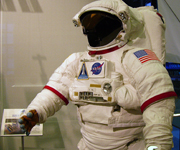
|
|---|
December 20, 2005 Updated
Two launch vehicles are under preparation at the VAB
First "double feature" in Japan
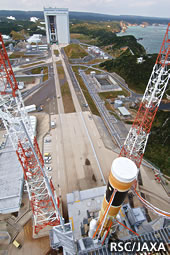 Final launch preparations are underway for the H-IIA Launch Vehicle No.8 (H-IIA F8) in the Vehicle Assembly Building (VAB) at the Tanegashima Space Center.
Final launch preparations are underway for the H-IIA Launch Vehicle No.8 (H-IIA F8) in the Vehicle Assembly Building (VAB) at the Tanegashima Space Center.
The launch vehicle in the photo (near side) is the H-IIA F9 which arrived at the launch site for the cryogenic test. The H-IIA F9 is scheduled to be launched in Feb. 2006. In the photo, you can barely see the H-IIA F8 behind the door (the world's largest) of the VAB 500 meters away from the F9.
We have previously had an opportunity to see multiple launch vehicles lying horizontally under operation at the same time, but this is the first time that two standing H-IIA launch vehicles have been under preparation in Tanegashima. The cryogenic test for the F9 went well.
Photo: H-IIA F8 in the VAB (far side) and H-IIA F9 (near side) on the pad (Dec. 19)
December 14, 2005 Updated
Hayabusa explorer moves to recovery operation mode
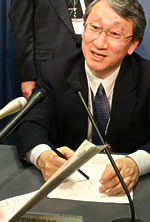 The status of the Hayabusa, which lost its attitude control when it left the Itokawa, has been gradually clarified. It seems that the attitude was shifted because gas that was generated due to evaporation of leaked propellant within the explorer had spilled out of the Hayabusa. Currently communications with the explorer have been cut off, but we think there is a high possibility that we can restore this if we take our time. Consequently, the project team redesigned the orbit to gain more time to save the Hayabusa. Under the latest schedule, the return to earth is scheduled for June 2010.
The status of the Hayabusa, which lost its attitude control when it left the Itokawa, has been gradually clarified. It seems that the attitude was shifted because gas that was generated due to evaporation of leaked propellant within the explorer had spilled out of the Hayabusa. Currently communications with the explorer have been cut off, but we think there is a high possibility that we can restore this if we take our time. Consequently, the project team redesigned the orbit to gain more time to save the Hayabusa. Under the latest schedule, the return to earth is scheduled for June 2010.
Photo: Project Manager Kawaguchi answering questions at a press conference
December 13, 2005 Updated
First success of the optical inter-orbit communication over 40,000 km
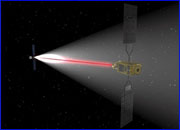 On December 9 (Japan Standard Time, JST), JAXA succeeded in an optical communication experiment between the "Kirari", which was launched by Ukraine's Dnepr launch vehicle on Aug. 24 (JST), and the Advanced Relay and Technology Mission (ARTEMIS) of the European Space Agency (ESA). The experiment was for two satellites that are moving several kilometers per second in respective orbits to communicate over a distance of about 40,000 kilometers. This requires a highly advanced controlling technology that can be described as like "hitting the eye of a needle on the top of Mt. Fuji from Tokyo Station." This success was a global first.
On December 9 (Japan Standard Time, JST), JAXA succeeded in an optical communication experiment between the "Kirari", which was launched by Ukraine's Dnepr launch vehicle on Aug. 24 (JST), and the Advanced Relay and Technology Mission (ARTEMIS) of the European Space Agency (ESA). The experiment was for two satellites that are moving several kilometers per second in respective orbits to communicate over a distance of about 40,000 kilometers. This requires a highly advanced controlling technology that can be described as like "hitting the eye of a needle on the top of Mt. Fuji from Tokyo Station." This success was a global first.
We would like to express our appreciation to the ESA and other people concerned for their cooperation with this experiment.
December 8, 2005 Updated
Seriously damaged Hayabusa making best efforts to come back to earth
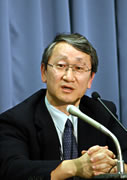 The Hayabusa project team has gradually restored communications between the Hayabusa, who lost its attitude control just after its touchdown on Nov. 26, and ground stations by taking various emergency measures. According to the very limited information received so far, "The explorer is still alive, but the communication function was seriously damaged. It is almost a miracle that it functions at all." (Mr. Kawaguchi, Project Manager)
The Hayabusa project team has gradually restored communications between the Hayabusa, who lost its attitude control just after its touchdown on Nov. 26, and ground stations by taking various emergency measures. According to the very limited information received so far, "The explorer is still alive, but the communication function was seriously damaged. It is almost a miracle that it functions at all." (Mr. Kawaguchi, Project Manager)
It was also found that there is a possibility that the projectile for sampling was not discharged. It is very hard to find out what has been really going on through only partial information. The project team will keep making its best efforts to have the explorer come back to earth including re-setting its orbit.
December 8, 2005 Updated
Launch of the Multi-functional Transport Satellite 2
by the H-IIA Launch Vehicle No. 9 (H-IIA F9)
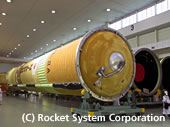 The Japan Aerospace Exploration Agency (JAXA) and Rocket System Corporation would like to announce that the launch of the Multi-functional Transport Satellite 2 (MTSAT-2) by the H-IIA Launch Vehicle No. 9 (H-IIA F9) was approved by the Space Activities Commission (SAC) as follows.
The Japan Aerospace Exploration Agency (JAXA) and Rocket System Corporation would like to announce that the launch of the Multi-functional Transport Satellite 2 (MTSAT-2) by the H-IIA Launch Vehicle No. 9 (H-IIA F9) was approved by the Space Activities Commission (SAC) as follows.
Scheduled data of launch:
February 15 (Wednesday), 2006 (Japan Standard Time, JST)
Launch window on Feb 15:
between 3:30 p.m. to 4:40 p.m. (JST)
(Launch time will vary depending on a launch day.)
Available launch days:
February 16 (Thursday) thru 28 (Tuesday) (JST)
Launch Site:
Yoshinobu Launch Complex at the Tanegashima Space Center
- For more information:
- Rocket System Corporation
November 2005
November 30, 2005 Updated
Hayabusa's attitude is unstable, restoring operations continue for safe return to earth
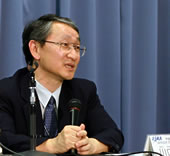 The Hayabusa, which successfully carried out a touchdown (landing and sampling) on the morning of the 26th, was autonomously switched to the "safe-hold mode" as its attitude was changed while ascending from the Itokawa. JAXA was able to stop a propellant leakage that is suspected as the cause of shaky attitude. Communications with the explorer were cut on the 27th and 28th, but the beacon line was restored at around 10:00 a.m. on the 29th. Restoring operations continue.
The Hayabusa, which successfully carried out a touchdown (landing and sampling) on the morning of the 26th, was autonomously switched to the "safe-hold mode" as its attitude was changed while ascending from the Itokawa. JAXA was able to stop a propellant leakage that is suspected as the cause of shaky attitude. Communications with the explorer were cut on the 27th and 28th, but the beacon line was restored at around 10:00 a.m. on the 29th. Restoring operations continue.
Photo: Professor Kawaguchi, Project Manager, at the press conference
November 28, 2005 Updated
880,000 people guided the Hayabusa
Successful touchdown a world first
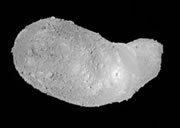 Just past 7:00 a.m. on the 26th (Japan Standard Time, JST), the second touchdown (landing and sampling) was carried out. The Hayabusa moved as programmed, and its ascending attitude after the touchdown was also stable.
Just past 7:00 a.m. on the 26th (Japan Standard Time, JST), the second touchdown (landing and sampling) was carried out. The Hayabusa moved as programmed, and its ascending attitude after the touchdown was also stable.
At 7:07 a.m. (JST) the sampler horn detected that its tip was deformed due to touching the Itokawa surface. Landing and sampling were then confirmed.
JAXA would like to extend our profound appreciation to all parties concerned for their support with this experiment.
The Hayabusa was autonomously switched to the "safe-hold mode" as it detected its attitude change.
"The Hayabusa may face more difficulties on its way back to earth, but we should renew our determination and do our utmost to complete this challenging mission successfully," said President Keiji Tachikawa of JAXA.
Photo: A target marker (with 880,000 signatures) released on the 20th and the shadow of the Hayabusa. The photo was taken while the explorer was descending.
November 26, 2005 Updated
Hayabusa is now ascending and Usuda Station is receiving data
 The Hayabusa had been descending toward the surface of the Itokawa since the evening of the 25th (Japan Standard Time, JST).
The Hayabusa had been descending toward the surface of the Itokawa since the evening of the 25th (Japan Standard Time, JST).
A final "Go" command for landing (touchdown) was issued at 6:20 a.m. today (JST), and the explorer made its final descent.
At 7:20 a.m. (JST) the Hayabusa started to ascend, and JAXA is now receiving data through the Usuda Station and will analyze it.
Photo: The Itokawa taken at 4:49 a.m. The shadow of the Hayabusa started to emerge.
November 25, 2005 Updated
Approaching the Itokawa again for another touchdown attempt (sampling)
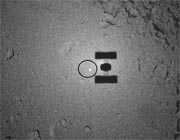 The Hayabusa, which became "the first explorer that took off from another astronomical body outside the geosphere (Earth zone)" (Professor Junichiro Kawaguchi, Project Manager), is now approaching the Itokawa again to carry out a second touchdown for sampling. Learning from the last experience, we will start operations (receiving data and sending commands) through a NASA station on the night of the 24th (Japan Standard Time, JST) while carefully checking the impact on the onboard sensors. We are aiming at performing landing and sampling at 7:00 a.m. on the 26th (JST).
The Hayabusa, which became "the first explorer that took off from another astronomical body outside the geosphere (Earth zone)" (Professor Junichiro Kawaguchi, Project Manager), is now approaching the Itokawa again to carry out a second touchdown for sampling. Learning from the last experience, we will start operations (receiving data and sending commands) through a NASA station on the night of the 24th (Japan Standard Time, JST) while carefully checking the impact on the onboard sensors. We are aiming at performing landing and sampling at 7:00 a.m. on the 26th (JST).
Photo:Target marker with signatures (image taken at the altitude of 32 meters)
November 24, 2005 Updated
Touchdown was successful
Hayabusa became the world's first explorer to land on and take off from an asteroid
 Data has shown that the Hayabusa bounced twice on the Itokawa, landed and stayed there for about 30 minutes before taking off following a command from the Earth.
Data has shown that the Hayabusa bounced twice on the Itokawa, landed and stayed there for about 30 minutes before taking off following a command from the Earth.
The above details of the first touchdown (landing and sampling) on the early morning of the 20th were clarified by analyzing data acquired from the Hayabusa after recovering its attitude from the "safe-hold mode." The Hayabusa is the world? first asteroid explorer to function properly after landing on an asteroid and taking off. Unfortunately, sampling was not carried out, but the explorer is currently approaching the Itokawa again, and JAXA is studying the possibility of a second touchdown. We will inform you more once the schedule is determined.
Photo:Target marker with signatures (image taken at the altitude of 32 meters)
November 20, 2005 Updated
Ready for another landing attempt after clarifying status of landing and sampling held on morning of the 20th
 The Hayabusa, which successfully released its target marker covered with 880,000 signatures on the Itokawa from a height of 40 meters, shifted its attitude to "safe-hold mode" for an unknown reason when it approached the asteroid.
The Hayabusa, which successfully released its target marker covered with 880,000 signatures on the Itokawa from a height of 40 meters, shifted its attitude to "safe-hold mode" for an unknown reason when it approached the asteroid.
We have to recover the attitude of the Hayabusa and make its high-gain antenna turn toward the earth to acquire more detailed data from the onboard equipment so that we can find out if the touchdown on the morning of the 20th was successful or not.
We will keep operating the Hayabusa to be ready for the next attempt.
Photo:Professor Junichi Kawaguchi, Project Manager, at a press conference
November 20, 2005 Updated
Target marker successfully released
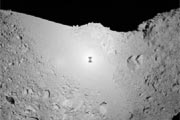 At 5:46 a.m. on the 20th (Japan Standard Time), JAXA received a signal from the asteroid explorer Hayabusa, which started descending toward the asteroid Itokawa on the night of the 19th for landing and sampling. The Hayabusa successfully released its target marker. The altitude of the Hayabusa at that time was about 40 meters, thus we are almost certain that the target marker reached the surface of the Itokawa.
At 5:46 a.m. on the 20th (Japan Standard Time), JAXA received a signal from the asteroid explorer Hayabusa, which started descending toward the asteroid Itokawa on the night of the 19th for landing and sampling. The Hayabusa successfully released its target marker. The altitude of the Hayabusa at that time was about 40 meters, thus we are almost certain that the target marker reached the surface of the Itokawa.
We are now gathering data from the Hayabusa and will provide more details about the touchdown.
Photo:An Itokawa's image captured at 4:58 JST.
November 18, 2005 Updated
First challenge of landing and sampling is early on the 20th morning
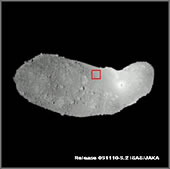 |
 |
The explorer, Hayabusa, is to carry out a world first landing and sampling on an asteroid based on data acquired during the observation and descending rehearsal. Re-approaching and landing are scheduled for 6:00 a.m. on the 20th (Japan Standard Time). We will provide real-time information from the operation room through the "Hayabusa-Live" Blog.
Photo: Muses Sea, the scheduled site for the sampling.
November 17, 2005 Updated
Cryogenic test completed for the H-IIA Launch Vehicle Flight No. 8
 On the 17th, a cryogenic test on the H-IIA Launch Vehicle Flight No. 8 was held to verify functions of the launch vehicle and ground support equipment.
On the 17th, a cryogenic test on the H-IIA Launch Vehicle Flight No. 8 was held to verify functions of the launch vehicle and ground support equipment.
The photo was taken by the live camera at Tanegashima yesterday.
November 14, 2005 Updated
Hayabusa was about 55 meters from the Itokawa during the rescheduled rehearsal for descending
Successfully verified the function of the Laser Ranging Finder (LRF)
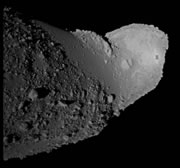 On the 12th, the rescheduled descending rehearsal for the Hayabusa was carried out for the functional verification of onboard equipment, the Laser Ranging Finder (LRF). During the rehearsal, the Hayabusa went as close as about 55 meters from the Itokawa. The function of the LRF was successfully verified, and the Hayabusa will perform the first sampling on the 19th. The separation of the probing robot, Minerva, released during the rehearsal, was confirmed, and communications have been maintained with it, although its current status is still unknown. We will inform you as soon as we have more details.
On the 12th, the rescheduled descending rehearsal for the Hayabusa was carried out for the functional verification of onboard equipment, the Laser Ranging Finder (LRF). During the rehearsal, the Hayabusa went as close as about 55 meters from the Itokawa. The function of the LRF was successfully verified, and the Hayabusa will perform the first sampling on the 19th. The separation of the probing robot, Minerva, released during the rehearsal, was confirmed, and communications have been maintained with it, although its current status is still unknown. We will inform you as soon as we have more details.
(Completed) Nov. 12: Rescheduled rehearsal for descending (Releasing a probing robot "Minerva")
Nov. 19: First sampling (Releasing a target marker with signatures)
Nov. 25: Second sampling
Photo: The Itokawa shot at 1:40 p.m. (Japan Standard Time) today. You can see the shadow of the Hayabusa.
November 11, 2005 Updated
Hayabusa approached within 70 meters of Itokawa
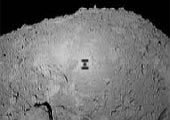 On Nov. 9, the Hayabusa moved within 70 meters of the Itokawa during a descending test that aimed to verify the guidance and navigation functions.
On Nov. 9, the Hayabusa moved within 70 meters of the Itokawa during a descending test that aimed to verify the guidance and navigation functions.
The cause of an anomaly that led to the cancellation of the rehearsal scheduled on Nov. 4 was clarified, thus we will carry out its landing at the "MUSES Sea" and sampling under the following schedule.
Nov. 12: Rescheduled rehearsal for descending (Release the probing robot "Minerva")
Nov. 19: First sampling (Release the target marker with signatures)
Nov. 25: Second sampling
Photo: The shade of the Hayabusa on the Itokawa.
November 7, 2005 Updated
November 4th descent aborted
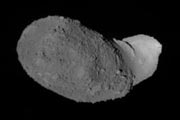 Due to a detection of anomalous signal at GO/NOGO decision, today's descent, including release of MINERVA and the target marker has been canceled.
Due to a detection of anomalous signal at GO/NOGO decision, today's descent, including release of MINERVA and the target marker has been canceled.
Distance from Itokawa to Hayabusa on November 6th is 9.6km.The spacecraft once ascended to a high altitude position.
Now traveling to the initial point of the Home Position box.
This is an image of Itokawa obtained at around 11:40 am(JST) on November 4th.
November 4, 2005 Updated
Hayabusa descending to the Itokawa
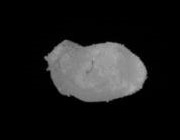 The asteroid explorer "Hayabusa" started to descend to the Itokawa at 4:00 a.m. on the 4th (Japan Standard Time, JST) as a rehearsal for the sampling scheduled later. During the descent, the Hayabusa will release its probing robot, Minerva, and a target marker with 880,000 names on it.
The asteroid explorer "Hayabusa" started to descend to the Itokawa at 4:00 a.m. on the 4th (Japan Standard Time, JST) as a rehearsal for the sampling scheduled later. During the descent, the Hayabusa will release its probing robot, Minerva, and a target marker with 880,000 names on it.
The distance between Hayabusa and Itokawa is now approximately 1 kilometer. (10:50 am JST)
November 2, 2005 Updated
Hayabusa's Scientific and Engineering Achievements during Proximity Operations around Itokawa
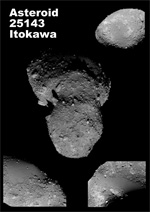 Hayabusa arrived at its exploration target, near Earth asteroid Itokawa, on September 12th of this year after having been propelled there via ion engines and an Earth swing-by. Since then, it has successfully performed orbital maneuvers, precisely keeping its position relative to Itokawa.
Hayabusa arrived at its exploration target, near Earth asteroid Itokawa, on September 12th of this year after having been propelled there via ion engines and an Earth swing-by. Since then, it has successfully performed orbital maneuvers, precisely keeping its position relative to Itokawa.
October 2005
October 31, 2005 Updated
The 13th Satellite Design Contest:
The "earth atmospheric flow observation satellite" won the best design award
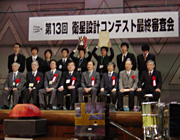 On Oct. 30, the 13th Satellite Design Contest was held, and among 14 finalists that were selected from 38 applicants, the "earth atmospheric flow observation" satellite designed by the graduate school of Tohoku University won the top prize, the best design award. The "washing in space!" satellite of Toba National College of Maritime Technology was awarded the best idea prize, and the newly established award for high school students competing in the Junior section went to the "making medicine in space" satellite of Asa High School in Yamaguchi Prefecture.
On Oct. 30, the 13th Satellite Design Contest was held, and among 14 finalists that were selected from 38 applicants, the "earth atmospheric flow observation" satellite designed by the graduate school of Tohoku University won the top prize, the best design award. The "washing in space!" satellite of Toba National College of Maritime Technology was awarded the best idea prize, and the newly established award for high school students competing in the Junior section went to the "making medicine in space" satellite of Asa High School in Yamaguchi Prefecture.
October 26, 2005 Updated
"Each one has a precious story" (Astronaut Noguchi)
Ceremony to return the Official Flight Kit of the Space Shuttle
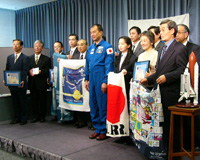 On October 26, a ceremony was held to mark the return of the Official Flight Kit, which was in space for 14 days onboard the Space Shuttle Discovery with Astronaut Noguchi, at the JAXA Tokyo office in Marunouchi, Tokyo. The items in the Kit were returned to the representatives of six organizations with a flight certificate. Astronaut Noguchi said, "Each of them has their own precious story. I hope each of you will further develop the story with them."
On October 26, a ceremony was held to mark the return of the Official Flight Kit, which was in space for 14 days onboard the Space Shuttle Discovery with Astronaut Noguchi, at the JAXA Tokyo office in Marunouchi, Tokyo. The items in the Kit were returned to the representatives of six organizations with a flight certificate. Astronaut Noguchi said, "Each of them has their own precious story. I hope each of you will further develop the story with them."
October 25, 2005 Updated
Open-house event held at TKSC
People enjoyed lectures and events on a clear autumn day
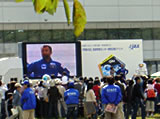 |
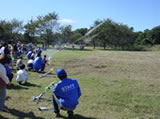 |
On Oct. 23 (Sun), an open-house event was held at the Tsukuba Space Center (TKSC) to mark Space Day. Thanks to the clear autumn weather, we were able to welcome about 7,800 visitors who enjoyed many events including water booster rocket launches and a special lecture by Astronaut Noguchi.
We would like to extend our sincere appreciation to all participants.
Thank you, and we hope you had a great day.
October 17, 2005 Updated
Astronaut Noguchi's debriefing at an open-house event
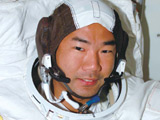 On Oct. 23 (Sun), an open-house event for "Space Day" in JFY 2005 will be held at the Tsukuba Space Center,and Astronaut Noguchi's debriefing is scheduled at an open-air stage specially set up in the center. (No reservation is required, and it will be held inside if it rains.) Many other events are also scheduled.
On Oct. 23 (Sun), an open-house event for "Space Day" in JFY 2005 will be held at the Tsukuba Space Center,and Astronaut Noguchi's debriefing is scheduled at an open-air stage specially set up in the center. (No reservation is required, and it will be held inside if it rains.) Many other events are also scheduled.
Please come and visit us.
October 10, 2005 Updated
Flight Trial Result of Scaled Experimental Supersonic Transport (SST)
The scaled experimental SST, launched at 7:06 (a.m.) on 10 October, 2005 local time, at the Woomera Test Range, Australia, flew and landed normally.
Flight condition planned to acquire the technical telemetry data was achieved.
JAXA expresses our profound gratitude to all parties concerned for cooperation in operating this flight trial of the scaled experimental SST.

October 4, 2005 Updated
Welcome back Astronaut Noguchi
Mission debriefing in Tokyo and Chigasaki
 Tokyo (10/1) |
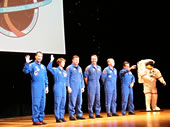 Chigasaki (10/2) |
A mission debriefing by Astronaut Noguchi was held in Odaiba, Tokyo, on Oct. 1 (Sat) and in Chigasaki, Kanagawa, on the 2nd (Sun). Some 1,200 participants at the Tokyo meeting site were thrilled by performances and revelations by surprise guests. During the question and answer session, Astronaut Noguchi walked around the audience. In Chigasaki, five other STS-114 crewmembers, including Commander Eileen Collins, attended the parade in addition to Astronaut Noguchi and all received a hearty welcome. We were very happy to be able to report the successful mission to those participants in the meetings and also to the general public on the street. JAXA would like to extend our sincere appreciation to all those who participated and supported these events.
September 2005
September 26, 2005 Updated
Space development events wrap up EXPO 2005
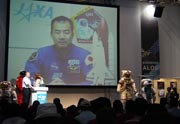
Thank you very much for coming to the exhibit "Our Future on Earth and in Space: Japan Explores the Universe" held as the final event of the 2005 World Exposition at Morizo-Kiccoro Messe. The event was co-sponsored by the Japan Association for the 2005 World Exposition and the Japan Aerospace Exploration Agency. We would like to extend our sincere appreciation to all participants.
September 16, 2005 Updated
Final event at EXPO 2005

The 2005 World Exposition, Aichi, Japan will end shortly. The exhibit "Our Future on Earth and in Space: Japan Explores the Universe" will be held as the final event at Morizo-Kiccoro Messe between September 17 and 25. The event is co-sponsored by the Japan Association for the 2005 World Exposition and the Japan Aerospace Exploration Agency.
Please come and join us.
September 12, 2005 Updated
Hayabusa arrives at target asteroid Itokawa
 The asteroid exploration probe, "Hayabusa", which has been traveling to its target, the Itokawa, arrived some 20km away from the asteroid at 10:00 a.m. on September 12 (Japan Standard Time), and is now stationary at the site.
The asteroid exploration probe, "Hayabusa", which has been traveling to its target, the Itokawa, arrived some 20km away from the asteroid at 10:00 a.m. on September 12 (Japan Standard Time), and is now stationary at the site.
Images acquired by the Hayabusa show the rough and rocky surface of the Itokawa. The Hayabusa will carry out a scientific probe including sample collections and topological investigations over about two months.
September 9, 2005 Updated
Asteroid explorer "Hayabusa" only 220 kilometers away from "Itokawa"
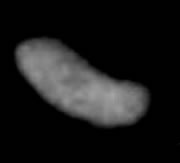 The asteroid explorer "Hayabusa" is smoothly approaching its target, the asteroid "Itokawa", and the distance is now about 220 kilometers between them. The Hayabusa is moving slowly at 7 km/hour. The Itokawa looks like a potato in the image taken on September 8. JAXA will next elucidate details of the surface of the asteroid based on the image data from now on.
The asteroid explorer "Hayabusa" is smoothly approaching its target, the asteroid "Itokawa", and the distance is now about 220 kilometers between them. The Hayabusa is moving slowly at 7 km/hour. The Itokawa looks like a potato in the image taken on September 8. JAXA will next elucidate details of the surface of the asteroid based on the image data from now on.
September 5, 2005 Updated
Asteroid explorer "Hayabusa" nearing target "Itokawa"
 As of the morning of September 4, the Hayabusa is approaching its target asteroid "Itokawa" at a slow relative speed of about 10 km per hour and is about 1,000 km from the asteroid. The image sent from 340 million kilometers away shows the Itokawa as a bright light of a few pixels.
As of the morning of September 4, the Hayabusa is approaching its target asteroid "Itokawa" at a slow relative speed of about 10 km per hour and is about 1,000 km from the asteroid. The image sent from 340 million kilometers away shows the Itokawa as a bright light of a few pixels.
August 2005
August 24, 2005 Updated
OICETS / INDEX successfully launched, the nicknames are the "Kirari" and "Reimei"
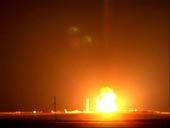 The Dnepr Launch Vehicle, which was launched at 6:10 a.m. on August 24, 2005, (Japan Standard Time, JST) from the Baikonur Cosmodrome in the Republic of Kazakhstan, flew normally, and separated the Optical Inter-orbit Communications Engineering Test Satellite (OICETS) and the Innovative Technology Demonstration Experiment Satellite (INDEX) about 15 minutes after liftoff.
The Dnepr Launch Vehicle, which was launched at 6:10 a.m. on August 24, 2005, (Japan Standard Time, JST) from the Baikonur Cosmodrome in the Republic of Kazakhstan, flew normally, and separated the Optical Inter-orbit Communications Engineering Test Satellite (OICETS) and the Innovative Technology Demonstration Experiment Satellite (INDEX) about 15 minutes after liftoff.
The nickname of the OICETS is the "Kirari", and that of the INDEX is "Reimei".
We would like to express our appreciation for cooperation and support from all related personnel and organizations that helped contribute to this successful launch.
August 16, 2005 Updated
Hayabusa probe photographs asteroid ITOKAWA
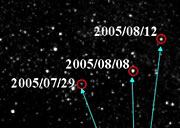 The asteroid probe Hayabusa, which was launched on May 9, 2003, from the Uchinoura Space Center, captured a photograph of the small asteroid "ITOKAWA". An image was taken by an onboard camera called the "Star Tracker" for attitude control. Although the image consisted of only a few pixels, it contributed to the final orbit correction in the final phase of a 27-month long space journey. During the trip, the Hayabusa used the earth's gravity in a fly-by and an ion engine.
The asteroid probe Hayabusa, which was launched on May 9, 2003, from the Uchinoura Space Center, captured a photograph of the small asteroid "ITOKAWA". An image was taken by an onboard camera called the "Star Tracker" for attitude control. Although the image consisted of only a few pixels, it contributed to the final orbit correction in the final phase of a 27-month long space journey. During the trip, the Hayabusa used the earth's gravity in a fly-by and an ion engine.
The relative distance between the ITOKAWA and the Hayabusa is about 35,000 km, which is about the same distance as the altitude of an earth geostationary orbit (as of Aug. 12.) In other words, it is located about 340 million km away from the earth with the sun in-between, or a radio wave from the earth takes about 40 minutes for a round trip. The observation team is planning for Hayabusa's arrival at ITOKAWA in mid September.
August 9, 2005 Updated
Discovery returned safely
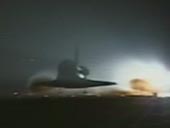 The National Aeronautics and Space Administration (NASA) advised that the Space Shuttle Discovery with Astronaut Noguchi onboard successfully landed at 9:11 p.m. on August 9, Japan Standard Time (JST), at the substitute landing site of Edwards Air Force Base in California, U.S.A., to complete its mission in 13 days, 21 hours and 32 minutes.
The National Aeronautics and Space Administration (NASA) advised that the Space Shuttle Discovery with Astronaut Noguchi onboard successfully landed at 9:11 p.m. on August 9, Japan Standard Time (JST), at the substitute landing site of Edwards Air Force Base in California, U.S.A., to complete its mission in 13 days, 21 hours and 32 minutes.
August 8, 2005 Updated
Discovery landing delayed for one day
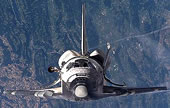 The landing of the Space Shuttle Discovery with Japanese astronaut Noguchi onboard was delayed for one day due to bad weather.
The landing of the Space Shuttle Discovery with Japanese astronaut Noguchi onboard was delayed for one day due to bad weather.
The new landing schedule at the Kennedy Space Center is at 6:07 p.m. on Aug. 9 (Tuesday), Japan Standard Time.
August 7, 2005 Updated
Discovery comes home on Aug. 8 (Monday)
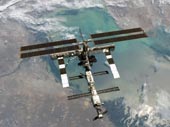 Crewmembers of the Discovery made their farewells to the crew of the International Space Station (ISS) at 1:36 p.m. on Aug. 6, Japan standard Time (JST), and detached the Shuttle from the ISS at 4:24 p.m. on the same day (JST) over the South Pacific Ocean just west of Chile.
Crewmembers of the Discovery made their farewells to the crew of the International Space Station (ISS) at 1:36 p.m. on Aug. 6, Japan standard Time (JST), and detached the Shuttle from the ISS at 4:24 p.m. on the same day (JST) over the South Pacific Ocean just west of Chile.
The Discovery is scheduled to leave its orbit at 4:40 p.m. on Aug. 8 (JST), and return to the Kennedy Space Center in Florida at 5:46 p.m. on the same day.
August 5, 2005 Updated
Answering a VIP call from Prime Minister Koizumi
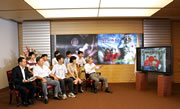 On Aug. 4 (Japan Standard Time, JST), a "VIP call" was held for 20 minutes from 6:19 p.m. (JST) by connecting the Prime Minister's official residence to the studio in the American module "Destiny" on the ISS. Prime Minister Koizumi praised Commander Collins as a "super woman with courage and talent", and talked to Astronaut Noguchi. "I feel like a very close friend of you as I see you on TV every day," said the prime minister. He then asked, "Is the earth really blue?", "how were the Chinese noodles?", and "how do you feel flying at a speed of 28,000km/hour?"
On Aug. 4 (Japan Standard Time, JST), a "VIP call" was held for 20 minutes from 6:19 p.m. (JST) by connecting the Prime Minister's official residence to the studio in the American module "Destiny" on the ISS. Prime Minister Koizumi praised Commander Collins as a "super woman with courage and talent", and talked to Astronaut Noguchi. "I feel like a very close friend of you as I see you on TV every day," said the prime minister. He then asked, "Is the earth really blue?", "how were the Chinese noodles?", and "how do you feel flying at a speed of 28,000km/hour?"
Astronaut Mouri worked as a facilitator during the call, and Minister Nakayama of the Ministry of Education, Culture, Sports, Science, and Technology and junior high school students also participated and talked to Astronaut Noguchi. During the 20 minutes, the ISS moved over Sydney pass the South Pacific Ocean to the Republic of Ecuador.
August 5, 2005 Updated
Discovery will return on Aug. 8
NASA decided to return the Discovery back to earth without conducting a fourth extravehicular activity to fix a thermal blanket near the commander's left window because NASA determined that the risk was minimal. The Discovery is scheduled to be detached from the ISS on the 6th, re-enter the atmosphere on the evening of the 8th, and land at 5:46 p.m. on the 8th (all dates and times are Japan Standard Time.) It will land at Kennedy Space Center in Florida unless the weather forces a change.
August 4, 2005 Updated
The third extravehicular activity was successfully completed
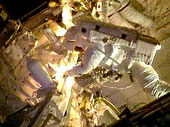 During the third extravehicular activity of the STS-114 mission, two protruding gap fillers were successfully removed with the "precision of a surgical operation." Astronaut Noguchi went out into space with Astronaut Robinson to support his operations.
During the third extravehicular activity of the STS-114 mission, two protruding gap fillers were successfully removed with the "precision of a surgical operation." Astronaut Noguchi went out into space with Astronaut Robinson to support his operations.
August 3, 2005 Updated
In-orbit press conference and the third extravehicular activity
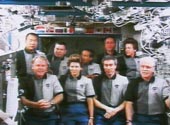 On Aug. 2, Day 8 of the STS-114 mission, seven crewmembers and two ISS long-stay astronauts had a joint in-orbit press conference, and part of it was done in Japanese. President Bush also expressed his appreciation to the crewmembers and sent words of encouragement to Japanese, Australian and Russian crewmembers on the phone.
On Aug. 2, Day 8 of the STS-114 mission, seven crewmembers and two ISS long-stay astronauts had a joint in-orbit press conference, and part of it was done in Japanese. President Bush also expressed his appreciation to the crewmembers and sent words of encouragement to Japanese, Australian and Russian crewmembers on the phone.
On Aug. 3, the third extravehicular activity started at 5:14 p.m., and the astronauts continue to work on the two protruding gap fillers from the tiles on the bottom of the Discovery.
August 2, 2005 Updated
Astronaut Noguchi carries out spacewalk to replace ISS part
 On Day 7 of the flight, Astronaut Noguchi carried out the second extravehicular activity.
On Day 7 of the flight, Astronaut Noguchi carried out the second extravehicular activity.
The purpose of the spacewalk this time was to replace the gyroscope (attitude control equipment) on the International Space Station (ISS). With his partner, Astronaut Robinson, they successfully completed the replacement.
August 1, 2005 Updated
Astronaut Noguchi's second extravehicular activity
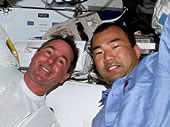 The STS-114 mission is now in its middle phase. On Day 6 of the flight, Astronaut Noguchi prepared the tools for the second extravehicular activity and held an interview with the media in America along with the other crewmembers.
The STS-114 mission is now in its middle phase. On Day 6 of the flight, Astronaut Noguchi prepared the tools for the second extravehicular activity and held an interview with the media in America along with the other crewmembers.
The second extravehicular activity started at around 5:00 p.m. on Aug. 1.
July 2005
July 31, 2005 Updated
Wake-up music was titled "Sanpo"
Astronaut Noguchi's first extravehicular activity
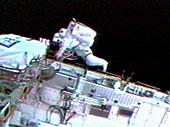 On the fifth day of the flight, Astronaut Noguchi carried out the first extravehicular activity. He is the second Japanese astronaut to carry out this task. The activity included a test repair of the Shuttle's insulation system, changing the electric cabling, and replacing the GPS antenna. Astronaut Noguchi is the first Japanese to perform an extravehicular activity at the International Space Station.
On the fifth day of the flight, Astronaut Noguchi carried out the first extravehicular activity. He is the second Japanese astronaut to carry out this task. The activity included a test repair of the Shuttle's insulation system, changing the electric cabling, and replacing the GPS antenna. Astronaut Noguchi is the first Japanese to perform an extravehicular activity at the International Space Station.
The wake-up music for the fifth day was "Sanpo" from the Japanese animation movie "Tonarino Totoro".
July 31, 2005 Updated
Discovery's mission was extended by one day, will return on Aug. 8
NASA advised it has extended the mission of the Space Shuttle Discovery by one day. The Shuttle will fly back to earth on Aug. 8 (Japan Standard Time).
July 30, 2005 Updated
Cooperative activities started between Discovery and ISS
Astronaut Noguchi gets ready for extravehicular activities
 On the fourth day of the flight, the crewmembers performed cooperative activities with the ISS onboard members, such as unloading the pressurized cargo carrier. They also carried out a survey of Discovery's thermal protection system, and so far, no apparent serious problems with Discovery's heat shield have been detected.
On the fourth day of the flight, the crewmembers performed cooperative activities with the ISS onboard members, such as unloading the pressurized cargo carrier. They also carried out a survey of Discovery's thermal protection system, and so far, no apparent serious problems with Discovery's heat shield have been detected.
Astronaut Noguchi prepared for the first extravehicular activity (EAV).
July 29, 2005 Updated
Discovery docked with ISS successfully
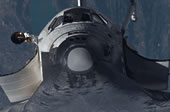 The Space Shuttle Discovery docked with the International Space Station (ISS) smoothly at 8:00 p.m. on the 28th (Japan Standard Time). The crew are currently inspecting the Discovery's condition.
The Space Shuttle Discovery docked with the International Space Station (ISS) smoothly at 8:00 p.m. on the 28th (Japan Standard Time). The crew are currently inspecting the Discovery's condition.
July 28, 2005 Updated
Discovery flight is progressing smoothly, ready to dock with ISS
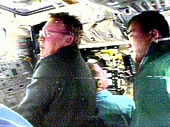 On the 2nd day of the flight of the Space Shuttle Discovery, the crew were preparing to dock with the International Space Station (ISS) and checking insulation tiles on the vehicle. Astronaut Noguchi inspected the airlock and spacesuit to be used for the extravehicular activity.
On the 2nd day of the flight of the Space Shuttle Discovery, the crew were preparing to dock with the International Space Station (ISS) and checking insulation tiles on the vehicle. Astronaut Noguchi inspected the airlock and spacesuit to be used for the extravehicular activity.
July 27, 2005 Updated
Launch of the Space Shuttle Discovery with Astronaut Noguchi Onboard
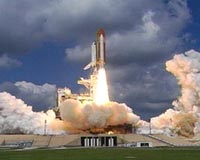 The National Aeronautics and Space Administration (NASA) launched the Space Shuttle Discovery with Astronaut Noguchi of JAXA onboard (STS-114 / International Space Station Assembly Resumption Mission, LF-1) at 10:39 a.m. on July 26 (Eastern Daylight Time, EDT) or at 11:39 p.m. on the same day, Japan Standard Time (JST), from the NASA Kennedy Space Center in Florida, U.S.A.
The National Aeronautics and Space Administration (NASA) launched the Space Shuttle Discovery with Astronaut Noguchi of JAXA onboard (STS-114 / International Space Station Assembly Resumption Mission, LF-1) at 10:39 a.m. on July 26 (Eastern Daylight Time, EDT) or at 11:39 p.m. on the same day, Japan Standard Time (JST), from the NASA Kennedy Space Center in Florida, U.S.A.
July 26, 2005 Updated
Crew starts to go onboard
 Seven astronauts, including Japanese Astronaut Noguchi, started to go onboard the Space Shuttle Discovery. Countdown operations are progressing smoothly. The liftoff is scheduled for 11:39 p.m., Japan Standard Time.
Seven astronauts, including Japanese Astronaut Noguchi, started to go onboard the Space Shuttle Discovery. Countdown operations are progressing smoothly. The liftoff is scheduled for 11:39 p.m., Japan Standard Time.
July 26, 2005 Updated
Go Discovery !
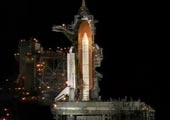 Countdown operations of the Space Shuttle Discovery are progressing smoothly.
Countdown operations of the Space Shuttle Discovery are progressing smoothly.
Operations are currently on hold for routine inspections. The hold is scheduled to end at three hours and 50 minutes prior to the liftoff time (around 7:30 p.m., Japan Standard Time). The crew members will then go onboard.
Then the target launch date and time will be:
at 10:39 a.m. on July 26 (Tue) (Eastern Daylight Time)
or
at 11:39 p.m. on July 26 (Tue) (Japan Standard Time).
July 26, 2005 Updated
Space Shuttle live broadcast and highlight broadcast
The launch of the Space Shuttle Discovery will be broadcast live at the following site on a large screen.
- Alta Vision Shinjuku (at the east exit of Shinjyuku Station)
- Between 11:35 and 11:45 p.m. on July 26 (for 10 minutes, Japan Standard Time)
- Highlight broadcast: one minute footage will be broadcast once every 30 minutes between 10:00 and 11:00 a.m. (JST) on July 30, 31, and from Aug. 5 thru 7.
July 21, 2005 Updated
Countdown operation will start on this coming weekend for the target launch day of July 26
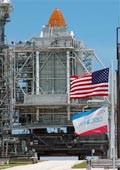 The target launch day of the Space Shuttle Discovery (STS-114) was announced as follows. If no anomaly is found during the test on the external fuel tank sensor system which is currently in progress, final launch countdown operations will be resumed on July 23 (Sat) (Eastern Daylight Time, EDT).
The target launch day of the Space Shuttle Discovery (STS-114) was announced as follows. If no anomaly is found during the test on the external fuel tank sensor system which is currently in progress, final launch countdown operations will be resumed on July 23 (Sat) (Eastern Daylight Time, EDT).
Then the target launch date and time will be:
at 10:39 a.m. on July 26 (Tue) (Eastern Daylight Time)
or
at 11:39 p.m. on July 26 (Tue) (Japan Standard Time).
July 20, 2005 Updated
Join the Institute of Space and Astronautical Science (ISAS) open-house event on July 23 (Sat.)
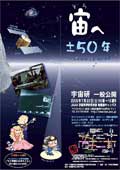 The annual ISAS open-house event provides visitors with the opportunity to see facilities that are usually closed and to experience the latest research results. Almost 20,000 visitors come to the event every year. We are preparing many projects, including a special lecture for the 50th anniversary of the pencil rocket, a mini-mini space class, making a plastic bottle rocket, and other experiments and quiz programs in which people can participate.
The annual ISAS open-house event provides visitors with the opportunity to see facilities that are usually closed and to experience the latest research results. Almost 20,000 visitors come to the event every year. We are preparing many projects, including a special lecture for the 50th anniversary of the pencil rocket, a mini-mini space class, making a plastic bottle rocket, and other experiments and quiz programs in which people can participate.
Why don't you come and join us at this cutting-edge space science venue.
- ISAS open-house event (Japanese language only)
July 19, 2005 Updated
Space Shuttle Launch: no earlier than July 26 (JST)
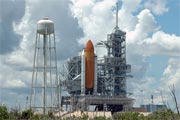 The new schedule of the launch of the Space Shuttle Discovery was announced to be no earlier than July 26 (Japan Standard Time, JST) as investigations continue.
The new schedule of the launch of the Space Shuttle Discovery was announced to be no earlier than July 26 (Japan Standard Time, JST) as investigations continue.
This information is also available on the following websites:
July 19, 2005 Updated
Launch day still undecided for Space Shuttle Discovery
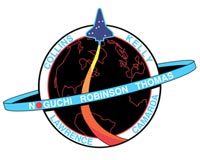 On the morning of the 16th (Japan Standard Time), it was announced that the launch day of the Space Shuttle Discovery (STS-114) had not been fixed yet as the investigation into the cause of the problem requires more time. The launch has been delayed due to an anomaly found in the fuel tank sensor system. Discovery can be launched four days after the cause is determined and countermeasures are completed.
On the morning of the 16th (Japan Standard Time), it was announced that the launch day of the Space Shuttle Discovery (STS-114) had not been fixed yet as the investigation into the cause of the problem requires more time. The launch has been delayed due to an anomaly found in the fuel tank sensor system. Discovery can be launched four days after the cause is determined and countermeasures are completed.
July 15, 2005 Updated
Space Shuttle Discovery: Earliest possible launch date is July 18 (JST)
 The new launch date of the Space Shuttle Discovery (STS-114), whose original launch was delayed due to a malfunction of the liquid fuel tank sensor, was announced to be no earlier than July 18 (Japan Standard Time, JST) as investigations continue.
The new launch date of the Space Shuttle Discovery (STS-114), whose original launch was delayed due to a malfunction of the liquid fuel tank sensor, was announced to be no earlier than July 18 (Japan Standard Time, JST) as investigations continue.
July 14, 2005 Updated
Space Shuttle Discovery launch delayed
 The Space Shuttle Discovery (STS-114) with seven astronauts including Japanese Astronaut Noguchi onboard was originally scheduled to be launched at 4:51 a.m. on July 14 (Japan Standard Time, JST). However, today's launch was cancelled due to an anomaly found in the fuel tank sensor system during countdown operations.
The Space Shuttle Discovery (STS-114) with seven astronauts including Japanese Astronaut Noguchi onboard was originally scheduled to be launched at 4:51 a.m. on July 14 (Japan Standard Time, JST). However, today's launch was cancelled due to an anomaly found in the fuel tank sensor system during countdown operations.
The possible new launch date will be no earlier than July 17 (JST).
July 13, 2005 Updated
Crew arrives at Kennedy Space Center
Countdown has also started
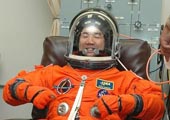 On the morning of July 10 (Japan standard time, JST), the crew of the STS-114 arrived at the Kennedy Space Center, where the launch of the Space Shuttle will be carried out, and held a press conference.
On the morning of July 10 (Japan standard time, JST), the crew of the STS-114 arrived at the Kennedy Space Center, where the launch of the Space Shuttle will be carried out, and held a press conference.
Final launch preparations are underway for the Space Shuttle Discovery, and the countdown has already started.
The launch is scheduled for 4:51 a.m. on July 14 (JST.)
July 13, 2005 Updated
X-ray astronomy satellite "Suzaku" operating smoothly
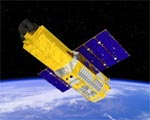 The operations of the X-ray astronomy satellite "Suzaku", which was launched by a M-V-6 launch vehicle from the Uchinoura Space Center in Kagoshima on July 10, are smoothly in progress.
The operations of the X-ray astronomy satellite "Suzaku", which was launched by a M-V-6 launch vehicle from the Uchinoura Space Center in Kagoshima on July 10, are smoothly in progress.
The satellite itself is also in good condition. So far, solar array deployment, attitude control mode establishment and X-ray telescope extension have been successfully performed. The orbit of the satellite is being modified for about two weeks, and the actual observation is scheduled to start in mid August.
July 10, 2005 Updated
M-V-6/ASTRO-EII successfully launched
The satellite nickname is "Suzaku"
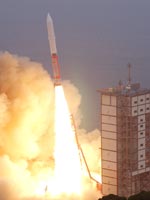 The M-V Launch Vehicle No. 6 (M-V-6) with the 23rd scientific satellite (ASTRO-EII) onboard was successfully launched at 12:30 p.m. on July 10, 2005 (Japan Standard Time, JST) from the Uchinoura Space Center (USC). The launch vehicle flew smoothly, and it was confirmed that the satellite was injected into the scheduled orbit.
The M-V Launch Vehicle No. 6 (M-V-6) with the 23rd scientific satellite (ASTRO-EII) onboard was successfully launched at 12:30 p.m. on July 10, 2005 (Japan Standard Time, JST) from the Uchinoura Space Center (USC). The launch vehicle flew smoothly, and it was confirmed that the satellite was injected into the scheduled orbit.
JAXA received signals from the ASTRO-EII at the Santiago tracking station and the USC, and from those signals we also verified that the ASTRO-EII had successfully separated.
The in-orbit ASTRO-EII was given a nickname of "Suzaku."
We would like to express our appreciation for the cooperation and support from all people and organizations that helped contribute to the successful launch of the M-V-6.
July 9, 2005 Updated
M-V-6/ASTRO-EII launch will be on July 10 (JST)
 The launch experiment of the M-V-6/ASTRO-EII) will be carried out on July 10 (Japan Standard Time, JST) from the Uchinoura Space Center in Kagoshima.
The launch experiment of the M-V-6/ASTRO-EII) will be carried out on July 10 (Japan Standard Time, JST) from the Uchinoura Space Center in Kagoshima.
We had previously announced that it would be rescheduled to no earlier than July 10 (JST) due to the adverse weather conditions, but after further study of the weather on July 9, we decided to conduct the experiment on July 10 (JST). The launch time will be between 12:30 and 1:00 p.m. (JST.)
July 7, 2005 Updated
Launch Experiment Day of M-V-6
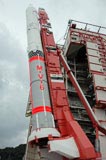 The launch experiment of the M-V Launch Vehicle No. 6 (M-V-6) with the 23rd scientific satellite (ASTRO-EII) onboard has been rescheduled to no earlier than July 10, 2005 (Japan Standard Time, JST).
The launch experiment of the M-V Launch Vehicle No. 6 (M-V-6) with the 23rd scientific satellite (ASTRO-EII) onboard has been rescheduled to no earlier than July 10, 2005 (Japan Standard Time, JST).
The launch experiment was originally scheduled on July 6, but was postponed due to the adverse weather conditions. We had previously announced that it would be rescheduled to no earlier than July 8 (JST), but after further study of the weather, we decided to postpone it to no earlier than July 10 (JST).
The new launch experiment date will be announced as soon as it is determined.
July 6, 2005 Updated
Postponement of the Launch Experiment the M-V-6
 The launch experiment of the M-V Launch Vehicle No. 6 (M-V-6) with the 23rd scientific satellite (ASTRO-EII) onboard has been rescheduled due to the adverse weather condition. The new launch day will be no earlier than July 8, 2005 (Japan Standard Time, JST) as there is no sign of weather recovery on the July 7.
The launch experiment of the M-V Launch Vehicle No. 6 (M-V-6) with the 23rd scientific satellite (ASTRO-EII) onboard has been rescheduled due to the adverse weather condition. The new launch day will be no earlier than July 8, 2005 (Japan Standard Time, JST) as there is no sign of weather recovery on the July 7.
The launch experiment was originally scheduled at 12:30 p.m. on July 6, 2005 (JST) from the Uchinoura Space Center.
The new launch experiment date will be announced as soon as it is determined.
July 4, 2005 Updated
Launch preparations for M-V-6/ASTRO-EII are on schedule
 Launch preparations are steadily in progress at the Uchinoura Space Center for the launch on July 6. On July 1, coordination operations for the angle of the launcher were shown to the press. The launch dress rehearsal was held on the third.
Launch preparations are steadily in progress at the Uchinoura Space Center for the launch on July 6. On July 1, coordination operations for the angle of the launcher were shown to the press. The launch dress rehearsal was held on the third.
July 1, 2005 Updated
July 13 (EDT) set as launch date for 13-day trip to ISS
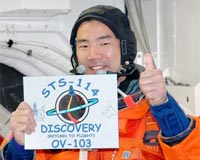 The launch date for the Discovery (STS-114) to the International Space Station (ISS) has been set for July 13 (Eastern Daylight Time). This ISS mission will tackle several important tasks including orbital operations for making space flight safer, adding modules to the ISS, and repairing equipment.
The launch date for the Discovery (STS-114) to the International Space Station (ISS) has been set for July 13 (Eastern Daylight Time). This ISS mission will tackle several important tasks including orbital operations for making space flight safer, adding modules to the ISS, and repairing equipment.
The seven crewmembers, including Astronaut Noguchi, are scheduled to return to the Kennedy Space Center (Florida, USA) on July 26, depending on the weather and the success of all planned operations.
For more details about the mission, please check the following website.
June 2005
June 30, 2005 Updated
Launch preparations for M-V-6/ASTRO-EII on schedule
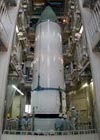 Launch preparations for the M-V Launch Vehicle Flight #6 with the X-ray astronomy satellite ASTRO-EII onboard is steadily in progress. The launch is scheduled on July 6 from the Uchinoura Space Center. All stages of the launch vehicle have been assembled with the encapsulated satellite on top of it.
Launch preparations for the M-V Launch Vehicle Flight #6 with the X-ray astronomy satellite ASTRO-EII onboard is steadily in progress. The launch is scheduled on July 6 from the Uchinoura Space Center. All stages of the launch vehicle have been assembled with the encapsulated satellite on top of it.
June 23, 2005 Updated
Space Music Contest
"Radio Emission" wins Space Music Contest
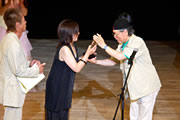 On June 21, the final selection was made for the Space Music Contest at the EXPO hall at the site of the 2005 World Exposition, Aichi Japan. "Radio Emission" by E. Bakay (group musicians) won the grand prix out of four pieces of music that were selected through the preliminary selection process among 637 entries.
On June 21, the final selection was made for the Space Music Contest at the EXPO hall at the site of the 2005 World Exposition, Aichi Japan. "Radio Emission" by E. Bakay (group musicians) won the grand prix out of four pieces of music that were selected through the preliminary selection process among 637 entries.
We would like to extend our gratitude to all the music applicants, voters for their selections, audiences at the hall, and all other people and parties concerned.
- Space Music Contest (Japanese language only)
(You can listen to the prize winning pieces of music from the Grand Prix and reviewers' special award.)
June 16, 2005 Updated
Discovery emerges in its flight configuration
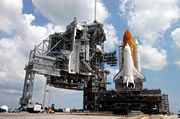 The direct cause of the Colombia accident was the falling insulation material from the external fuel tank at liftoff. After various tests and a lengthy review period, NASA postponed the launch schedule of the Discovery to install a heater on the important parts of the tank so that insulation material, or ice coming off from the external tank, will not hit the orbiter. The renovated tank, orbiter, and solid rocket booster were all mated and loaded on the launch pad. The Discovery has emerged in its launch configuration.
The direct cause of the Colombia accident was the falling insulation material from the external fuel tank at liftoff. After various tests and a lengthy review period, NASA postponed the launch schedule of the Discovery to install a heater on the important parts of the tank so that insulation material, or ice coming off from the external tank, will not hit the orbiter. The renovated tank, orbiter, and solid rocket booster were all mated and loaded on the launch pad. The Discovery has emerged in its launch configuration.
June 8, 2005 Updated
Participants wanted for our events, art work contest
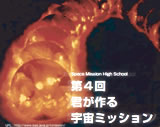 JAXA is looking for participants in events including academic meetings and campaigns, as well as seeking art work for contests. The current event schedule is as follows (in the order of the closing dates.)
JAXA is looking for participants in events including academic meetings and campaigns, as well as seeking art work for contests. The current event schedule is as follows (in the order of the closing dates.)
"International Astronautical Congress" to be held in Oct. in Fukuoka. University students' participation is welcomed. (Closing date: June 10)
"Final Selection for Space Music" on June 21 at the Aichi Exposition site, some judges from the general public are wanted. (Closing date: June 10)
"Space Mission Proposed by You" in Aug. at Sagamihara Campus, high school students are welcomed. (Closing date: June 20)
"Cosmic College, Educators Course" (Closing date: June 24)
"Science Camp 2005" (Closing date: June 27)
"Composition and Drawing Contests for Elementary and Junior High School Students" (Closing date: July 15)
June 2, 2005 Updated
Launch date rescheduled for ASTRO-EII
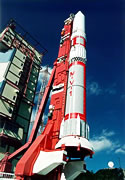 On June 1, JAXA reported to the Space Activities Commission that it will reschedule the launch of the M-V ("Mu five") launch vehicle with the ASTRO-EII ("Astor E-two") onboard to either between July 6 and 15 or between July 22 and Aug. 2. The launch will be conducted at the Uchinoura Space Center on the Osumi Peninsula in Kagoshima.
On June 1, JAXA reported to the Space Activities Commission that it will reschedule the launch of the M-V ("Mu five") launch vehicle with the ASTRO-EII ("Astor E-two") onboard to either between July 6 and 15 or between July 22 and Aug. 2. The launch will be conducted at the Uchinoura Space Center on the Osumi Peninsula in Kagoshima.
- The report to the Space Activities Commission (Japanese language only)
- ASTRO-EII
- Uchinoura Space Center (VISIT JAXA)
May 2005
May 30, 2005 Updated
What can JAXA do to contribute to the prevention of global warming?
The GOSAT symposium was successfully completed
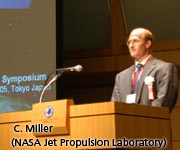 On May 27 (Friday), the Greenhouse Gases Observing Satellite (GOSAT) symposium was held at the Tokyo International Forum in Yurakucho. More than 200 participants were at the symposium, indicating that many people have a high interest in satellites. Several interesting lectures on expectations for the GOSAT project were held, including one by non-fiction writer Mr. Kazuma Yamane. We would like to extend our gratitude to all participants.
On May 27 (Friday), the Greenhouse Gases Observing Satellite (GOSAT) symposium was held at the Tokyo International Forum in Yurakucho. More than 200 participants were at the symposium, indicating that many people have a high interest in satellites. Several interesting lectures on expectations for the GOSAT project were held, including one by non-fiction writer Mr. Kazuma Yamane. We would like to extend our gratitude to all participants.
- GOSAT symposium (Japanese language only)
- Greenhouse gases Observing SATellite (GOSAT)
May 25, 2005 Updated
Please participate in the GOSAT symposium
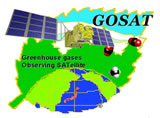 On May 27 (Friday), the Greenhouse Gases Observing Satellite (GOSAT) symposium will be held at the Tokyo International Forum in Yurakucho. Apart from a presentation on the outline of the GOSAT project, other interesting programs are scheduled including a lecture on the expectations of the GOSAT project by non-fiction writer Mr. Kazuma Yamane.
On May 27 (Friday), the Greenhouse Gases Observing Satellite (GOSAT) symposium will be held at the Tokyo International Forum in Yurakucho. Apart from a presentation on the outline of the GOSAT project, other interesting programs are scheduled including a lecture on the expectations of the GOSAT project by non-fiction writer Mr. Kazuma Yamane.
You need to register in advance to participate through the following link.
- GOSAT symposium (Japanese language only)
- Greenhouse gases Observing SATellite (GOSAT)
May 20, 2005 Updated
"Space Education Center" opened at Sagamihara Campus
 On May 19, the "Space Education Center," which plays a major role in JAXA's practical educational activities, started its operations at the Sagamihara Campus. It is an organization to actively promote a broad range of educational activities including accepting students, supporting teachers, and providing teaching materials. The center's slogan is "space awakens children's curiosity" (Dr. Yasunori Matogawa, JAXA Associate Executive Director and the head of the center.) During the opening ceremony, a signboard handwritten by JAXA President Tachikawa was hung at the entrance of the center.
On May 19, the "Space Education Center," which plays a major role in JAXA's practical educational activities, started its operations at the Sagamihara Campus. It is an organization to actively promote a broad range of educational activities including accepting students, supporting teachers, and providing teaching materials. The center's slogan is "space awakens children's curiosity" (Dr. Yasunori Matogawa, JAXA Associate Executive Director and the head of the center.) During the opening ceremony, a signboard handwritten by JAXA President Tachikawa was hung at the entrance of the center.
- Establishment of the "Space Education Center" (Report to the Space Activities Commission on May 18) (Japanese language only)
- Space Education Center Website(Japanese language only)
May 16, 2005 Updated
Model rocket launch and clear Earth observation images applauded at EOC open-house
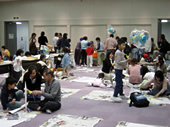 On May 14 (Sat), the JAXA Earth Observation Center (EOC) at Hatoyama in Saitama Prefecture held an open house event. The center, that is usually very quiet, was filled with the cheers of participants who enjoyed many events including looking at Earth observation images like they were observing them from an airborne satellite and the launching of hand-made model rockets.
On May 14 (Sat), the JAXA Earth Observation Center (EOC) at Hatoyama in Saitama Prefecture held an open house event. The center, that is usually very quiet, was filled with the cheers of participants who enjoyed many events including looking at Earth observation images like they were observing them from an airborne satellite and the launching of hand-made model rockets.
Even though the center is remotely located to avoid radio frequency interference, some 1,400 people visited us. Thank you very much.
May 13, 2005 Updated
Earth Observation Center open house
Join us at Hatoyama, Saitama, on May 14
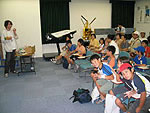 The Earth Observation Center (Hatoyama, Saitama Prefecture), where radio signals are received from earth observation satellites, will hold an open-house event on May 14. You can visit facilities to receive and analyze radio frequencies from satellites. We also will prepare various events including a "quiz rally."
The Earth Observation Center (Hatoyama, Saitama Prefecture), where radio signals are received from earth observation satellites, will hold an open-house event on May 14. You can visit facilities to receive and analyze radio frequencies from satellites. We also will prepare various events including a "quiz rally."
We look forward to seeing you!
- Earth Observation Center open house (Japanese language only)
- VISIT JAXA
May 9, 2005 Updated
The 4th JAXA Town Meeting in Kanazawa
Discussing space development on a fresh spring day
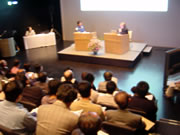 On May 8, the fourth JAXA Town Meeting was held at the 21st Century Museum of Contemporary Art in Kanazawa (Ishikawa Prefecture). The Town Meeting has been held in various places since the first one was held in Miyakonojyo (Miyazaki Prefecture) in May 2004. Over 130 participants held enthusiastic discussions on the objectives of Japanese space development and where it should go in the future, while Astronaut Takao Doi and Dr. Yasunori Matogawa, Associate Executive Director, answered questions. We would like to extend our sincere appreciation to all participants, applicants and parties involved. For future Town Meeting schedules and reports on the results of past meetings, please check the following site.
On May 8, the fourth JAXA Town Meeting was held at the 21st Century Museum of Contemporary Art in Kanazawa (Ishikawa Prefecture). The Town Meeting has been held in various places since the first one was held in Miyakonojyo (Miyazaki Prefecture) in May 2004. Over 130 participants held enthusiastic discussions on the objectives of Japanese space development and where it should go in the future, while Astronaut Takao Doi and Dr. Yasunori Matogawa, Associate Executive Director, answered questions. We would like to extend our sincere appreciation to all participants, applicants and parties involved. For future Town Meeting schedules and reports on the results of past meetings, please check the following site.
- JAXA Town Meeting (Japanese language only)
April 2005
April 28, 2005 Updated
Information from "JAXA Kids"

April 27, 2005 Updated
Symposium "JAXA 2025, The World of Aerospace"
Successfully completed with active opinion exchange
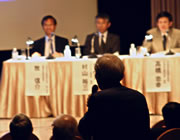 The above symposium was held on the afternoon of the 25th at Keidanren Kaikan (Tokyo). After the presentation on the long-term vision plan and lectures by invited guests, participants actively exchanged opinions, which were inspired by candid comments on the long-term vision plan such as, "It sounded like JAXA was just trying to please everybody" (Mr. Kazuma Nakane), and "Is JAXA pretending to be too healthy?" (Mr. Fujio Nakano).
The above symposium was held on the afternoon of the 25th at Keidanren Kaikan (Tokyo). After the presentation on the long-term vision plan and lectures by invited guests, participants actively exchanged opinions, which were inspired by candid comments on the long-term vision plan such as, "It sounded like JAXA was just trying to please everybody" (Mr. Kazuma Nakane), and "Is JAXA pretending to be too healthy?" (Mr. Fujio Nakano).
Not only the panelists on the podium but also some business people, Diet members, and people in charge of the vision project had a lively discussion.
We would like to express our appreciation to all participants and supporters.
April 26, 2005 Updated
Thank you for joining our open-house events
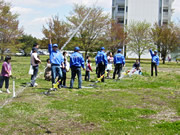 JAXA held open-house events at many of our facilities last weekend (Sat. 23rd and Sun. 24th). They were part of the events for the Science and Technology week. We were very happy to see many people visit us, including a record of over 5,800 people to the Tsukuba Space Center. We would like to extend our appreciation to all visitors.
JAXA held open-house events at many of our facilities last weekend (Sat. 23rd and Sun. 24th). They were part of the events for the Science and Technology week. We were very happy to see many people visit us, including a record of over 5,800 people to the Tsukuba Space Center. We would like to extend our appreciation to all visitors.
April 22, 2005 Updated
Science and Technology Week events: JAXA open-house
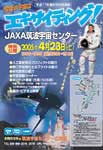 For Science and Technology Week from April 18 to 24, JAXA will hold its customary open-house events. On this coming weekend you can take a look at some facilities that you cannot normally visit and participate in many other events prepared by JAXA and volunteer staff. Please check "VISIT JAXA" for more details, and drop by and visit.
For Science and Technology Week from April 18 to 24, JAXA will hold its customary open-house events. On this coming weekend you can take a look at some facilities that you cannot normally visit and participate in many other events prepared by JAXA and volunteer staff. Please check "VISIT JAXA" for more details, and drop by and visit.
- VISIT JAXA( On this weekend, we will have an open-house in Tsukuba, Chofu, Katsuura, Tanegashima and Okinawa.)
- MEXT Regional Event Search Site (Japanese language only)
April 18, 2005 Updated
Science and technology week events: "Space and Technology Lecture and Movie" was held in Tokyo
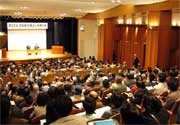 Many events are being held for the science and technology week from April 18 to 24. In Tokyo, a "Space and Technology Lecture and Movie" was held. Themes of the event included "50 years of the Pencil Rocket" and "X-ray Astronomical Observation". The Kakuda Space Propulsion Center (KSPC) in Miyagi Prefecture had an open-house event. Many events including open-house are scheduled for this weekend. Please drop by and visit.
Many events are being held for the science and technology week from April 18 to 24. In Tokyo, a "Space and Technology Lecture and Movie" was held. Themes of the event included "50 years of the Pencil Rocket" and "X-ray Astronomical Observation". The Kakuda Space Propulsion Center (KSPC) in Miyagi Prefecture had an open-house event. Many events including open-house are scheduled for this weekend. Please drop by and visit.
- VISIT JAXA
- Space Technology Lecture and Movie on April 16 (Japanese language only)
- Kakuda Space Propulsion Center Open-house
- MEXT Regional Event Search Site (Japanese language only)
April 14, 2005 Updated
Science and technology events to start from this weekend
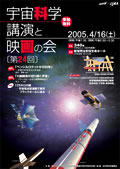 Many events for the science and technology week from April 18 to 24 will start this coming weekend. In Tokyo, a "Space and Technology Lecture and Movie" will be held. Themes of the event include "50 years of the Pencil Rocket" and "X-ray Astronomical Observation". The Kakuda Space Propulsion Center (KSPC) in Miyagi Prefecture will have an open-house event for some facilities including the High Temperature Shock Tunnel and the Cryogenic Inducer Test Facility.
Many events for the science and technology week from April 18 to 24 will start this coming weekend. In Tokyo, a "Space and Technology Lecture and Movie" will be held. Themes of the event include "50 years of the Pencil Rocket" and "X-ray Astronomical Observation". The Kakuda Space Propulsion Center (KSPC) in Miyagi Prefecture will have an open-house event for some facilities including the High Temperature Shock Tunnel and the Cryogenic Inducer Test Facility.
Please drop by and visit.
- VISIT JAXA
- Space Technology Lecture and Movie on April 16 (Japanese language only)
- Kakuda Space Propulsion Center Open-house
- MEXT Regional Event Search Site (Japanese language only)
April 8, 2005 Updated
Press conference with Astronaut Noguchi was held in the morning of April 8.
Live report was also available on NASA TV
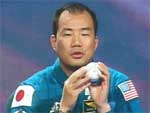 Astronaut Soichi Noguchi, who is scheduled to be a crew member of STS-114, Space Shuttle Discovery, held a press conference between 8:30 and 9:30 a.m. on April 8 (Japan Standard Time). This was the last conference before the flight. The conference was broadcast by connecting NASA Johnson Space Center and JAXA Tokyo office. It was also broadcast by NASA TV.
Astronaut Soichi Noguchi, who is scheduled to be a crew member of STS-114, Space Shuttle Discovery, held a press conference between 8:30 and 9:30 a.m. on April 8 (Japan Standard Time). This was the last conference before the flight. The conference was broadcast by connecting NASA Johnson Space Center and JAXA Tokyo office. It was also broadcast by NASA TV.
April 7, 2005 Updated
Press conference with Astronaut Noguchi set for morning of April 8.
Live report is also available on NASA TV
 Astronaut Soichi Noguchi, who is scheduled to be a crew member of STS-114, Space Shuttle Discovery, is to hold a press conference between 8:15 and 9:15 a.m. on April 8 (Japan Standard Time). This will be the last conference before the flight. The conference will be broadcast by connecting NASA Johnson Space Center and JAXA Tokyo office. It will also be broadcast by NASA TV.
Astronaut Soichi Noguchi, who is scheduled to be a crew member of STS-114, Space Shuttle Discovery, is to hold a press conference between 8:15 and 9:15 a.m. on April 8 (Japan Standard Time). This will be the last conference before the flight. The conference will be broadcast by connecting NASA Johnson Space Center and JAXA Tokyo office. It will also be broadcast by NASA TV.
April 5, 2005 Updated
Singapore GPS ground station moved 2 cms due to quake off Sumatra Island
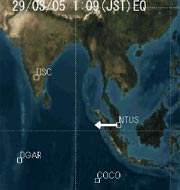 JAXA analyzes published data from GPS stations around the world for our own purposes to improve the accuracy of orbiting satellites. According to our analysis of various ground station locations before and after the earthquake off Sumatra Island on March 29 (measurng 8.7 on the richter scale), we found that the Singapore GPS station moved two centimeters to the west.
JAXA analyzes published data from GPS stations around the world for our own purposes to improve the accuracy of orbiting satellites. According to our analysis of various ground station locations before and after the earthquake off Sumatra Island on March 29 (measurng 8.7 on the richter scale), we found that the Singapore GPS station moved two centimeters to the west.
- JAXA CST-DAD(The article is in Japanese)
March 2005
March 30, 2005 Updated
"Cosmic College" for children who want to learn more about space and go there someday
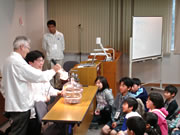 The "Cosmic College - Fundamental Course" was held at 10 venues around Japan between March 20 and 29. The course this time was targeting children who would be sixth graders or junior high school students from this coming April. We plan to conduct various courses over this coming summer and later such as the "advanced course", the"kids' course" for first to third graders, and the"educators' course" for those who are in the teaching field. We will provide more information about the venue and registration process of each course on this website.
The "Cosmic College - Fundamental Course" was held at 10 venues around Japan between March 20 and 29. The course this time was targeting children who would be sixth graders or junior high school students from this coming April. We plan to conduct various courses over this coming summer and later such as the "advanced course", the"kids' course" for first to third graders, and the"educators' course" for those who are in the teaching field. We will provide more information about the venue and registration process of each course on this website.
- "Cosmic Collage" is one of the JAXA's activities to educate young people. (Japanese language only)
March 23, 2005 Updated
JAXA received a final report from the Honorable Daniel S.
Goldin, Former NASA Administrator
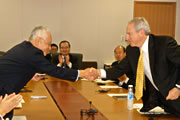 JAXA established an external Advisory Commission for development-related basic issues in June 2004 in order to seek advice from domestic and non-Japanese experts for mid- to long-term prospectives. On Feb. 23, the final report from the commission was handed to President Tachikawa of JAXA.
JAXA established an external Advisory Commission for development-related basic issues in June 2004 in order to seek advice from domestic and non-Japanese experts for mid- to long-term prospectives. On Feb. 23, the final report from the commission was handed to President Tachikawa of JAXA.
March 22, 2005 Updated
Go with a muchlock gunfire!
Tanegashima Rocket Marathon completed
 The 18th Tanegashima Rocket Marathon for runners was held on Tanegashima island on March 20 (Sun).
The 18th Tanegashima Rocket Marathon for runners was held on Tanegashima island on March 20 (Sun).
Although it rained during the marathon, it cleared up by the time of the finish. The award ceremony was held in front of the life-size H-II launch vehicle model at the center.
For more detailes, please look at the "VISIT JAXA".
- Minami-Tane Cho Website (Japanese language only)
- Tanegashima Space Center (VISIT JAXA)
March 18, 2005 Updated
Matchlock gunfire to start "Tanegashima Rocket Marathon"
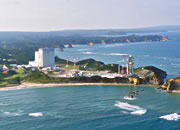 The 18th Tanegashima Rocket Marathon will be held on March 20 (Sun). Several choices of courses are prepared for participants namely the full marathon (certified by the Japan Association of Athletic federations),the half marathon, and 10 km, 5 km, 3 km, and 2km courses. The goal is at the Tanegashima Space Center. Organizers and participants may want to check the weather information below.
The 18th Tanegashima Rocket Marathon will be held on March 20 (Sun). Several choices of courses are prepared for participants namely the full marathon (certified by the Japan Association of Athletic federations),the half marathon, and 10 km, 5 km, 3 km, and 2km courses. The goal is at the Tanegashima Space Center. Organizers and participants may want to check the weather information below.
- Minami-Tane Cho Website (Japanese language only)
- Tanegashima Space Center Weather Information (Japanese language only)
- Tanegashima Space Center (VISIT JAXA)
March 17, 2005 Updated
Assembly of the M-V Launch Vehicle No.6 in progress
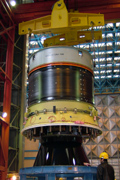 The second phase assembly operations of the M-V Launch Vehicle No. 6 have been started after the launch vehicle team commenced their work on February 23. The first and second stage motors have already been mated at the vehicle assembly building, and the second stage onboard equipment section and the third stage motor were being assembled on the 14th. The assembly operations were open to the press.
The second phase assembly operations of the M-V Launch Vehicle No. 6 have been started after the launch vehicle team commenced their work on February 23. The first and second stage motors have already been mated at the vehicle assembly building, and the second stage onboard equipment section and the third stage motor were being assembled on the 14th. The assembly operations were open to the press.
- Institute of Space and Astronautical Science
Assembly of the M-V Launch Vehicle No.6 in progress(Japanese language only)
February 2005
February 26, 2005 Updated
Launch Result of MTSAT-1R/H-IIA F7
 The H-IIA Launch Vehicle No. 7 (H-IIA F7) with the Multi-functional Transport Satellite-1 Replacement (MTSAT-1R) onboard was launched at 6:25 p.m. on February 26, 2005 (Japan Standard time). The initial flight angle was 102 degrees.
The H-IIA Launch Vehicle No. 7 (H-IIA F7) with the Multi-functional Transport Satellite-1 Replacement (MTSAT-1R) onboard was launched at 6:25 p.m. on February 26, 2005 (Japan Standard time). The initial flight angle was 102 degrees.
The launch vehicle flew smoothly, and, at 40 minutes and 2 seconds after liftoff, the MTSAT-1R separation was confirmed.
We would like to express our profound appreciation for the cooperation and support of all related personnel and organizations that helped contribute to the successful launch of the H-IIA F7.
For your information, the satellite was named "Himawari (meaning "sunflower") No. 6".
February 24, 2005 Updated
New Launch Day of MTSAT-1R/H-IIA F7 is Feb. 26
The launch of the H-IIA Launch Vehicle No. 7 (H-IIA F7) with the Multi- functional Transport Satellite-1 Replacement (MTSAT-1R) onboard has been rescheduled to no earlier than February 26, 2005 (Japan Standard Time, JST) due to unfavorable weather.
Today, after the weather forecast was thoroughly examined, the new launch date was determined to be February 26.
February 22, 2005 Updated
Launch Postponement of MTSAT-1R/H-IIA F7
The launch of the H-IIA Launch Vehicle No. 7 (H-IIA F7) with the Multi-functional Transport Satellite-1 Replacement (MTSAT-1R) onboard has been rescheduled due to unfavorable weather. The new launch day will be no earlier than February 26 (Sat), 2005 (Japan Standard Time, JST).
The launch was originally scheduled on February 24 (Thu), 2005 (JST) from the Tanegashima Space Center.
The new launch date will be announced as soon as it is determined.
February 21, 2005 Updated
H-IIA F7: moved into countdown operations
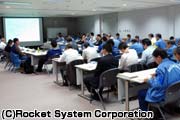 The launch preparation for the H-IIA Launch Vehicle No.7 has been underway.The launch has been commissioned to Rocket System Corporation(RSC).
The launch preparation for the H-IIA Launch Vehicle No.7 has been underway.The launch has been commissioned to Rocket System Corporation(RSC).
On the 19th (Sat), the final launch readiness review was held as scheduled to confirm current operations and the preparation status for launch. As a result ofthe review, it was determined to move into countdown operations, and on the 20th (Sun), the "three days before the launch day operations (Y-3 countdown operations)" were carried out for the Multi-functional Transport Satellite-1 Replacement (MTSAT-1R) and the H-IIA Launch Vehicle Flight No.7.
February 18, 2005 Updated
H-IIA F7: Final checkout for the launch vehicle
The launch preparation for the H-IIA Launch Vehicle No.7 has been underway.The launch has been commissioned to Rocket System Corporation(RSC).
The final functional checkout is being performed on schedule at the Tanegashima Space Center today. An inspection of the electrical systems is being carried out and mostly covers checking the circuit for pyrotechnics attached to the fairing section for payload separation, functional verification of the onboard CCD cameras, and inspection of the batteries.
February 16, 2005 Updated
H-IIA F7: satellite and veheicle finally mated
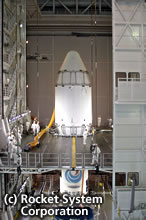 The launch preparation for the H-IIA Launch Vehicle No.7 has been underway. The launch has been commissioned to Rocket System Corporation(RSC).
The launch preparation for the H-IIA Launch Vehicle No.7 has been underway. The launch has been commissioned to Rocket System Corporation(RSC).
After moving to the VAB, the encapsulated satellite is now being slung to the top of the launch vehicle to be loaded onto the second stage. The MTSAT-1R has been prepared for launch since in the SFA-2, and the launch vehicle has been done so in the VAB. After separated preparation operations, the satellite and vehicle are finally mated in one piece.
February 14, 2005 Updated
H-IIA F7: Payload and launch vehicle mating
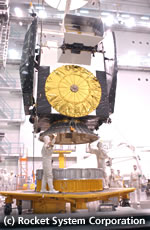 Launch operations for the H-IIA Launch Vehicle No. 7 (H-IIA F7), scheduled to be launched on Feb. 24, are proceeding smoothly.
Launch operations for the H-IIA Launch Vehicle No. 7 (H-IIA F7), scheduled to be launched on Feb. 24, are proceeding smoothly.
On Feb. 8, a payload of the H-IIA F7, the Multi-functional Transport Satellite-1Replacement (MTSAT-1R) was mated with a payload adapter that is a separation part of the payload and launch vehicle. Preparations are underway for encapsulating the payload by the fairing, which is scheduled for Feb. 10 and 11.
February 7, 2005 Updated
The cryogenic test on the H-IIA F7
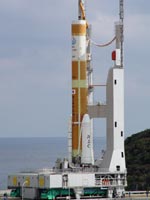 The cryogenic test on the H-IIA Launch Vehicle No. 7 (H-IIA F7) was successfully completed on Feb. 6 (Sun). The H-IIA F7 is scheduled to be launched on Feb. 24.
The cryogenic test on the H-IIA Launch Vehicle No. 7 (H-IIA F7) was successfully completed on Feb. 6 (Sun). The H-IIA F7 is scheduled to be launched on Feb. 24.
The purpose of the test is to verify the functions by filling liquid propellants (liquid hydrogen and oxygen) into the launch vehicle in the same process as that of the launch day.
February 2, 2005 Updated
H-IIA Launch Vehicle Flight No.7 (H-IIA F7) countdown page
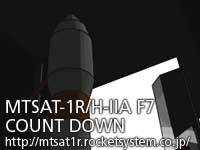 The countdown site for the H-IIA F7, which is scheduled for launch on Feb. 24, has just been opened.
The countdown site for the H-IIA F7, which is scheduled for launch on Feb. 24, has just been opened.
The launch has been commissioned to Rocket System Corporation (RSC).
The site is full of information about launch activities including multimedia materials. Please visit and enjoy the site.
January 2005
January 31, 2005 Updated
Launch Preparation Status for H-IIA Launch Vehicle No.7 (H-IIA F7)
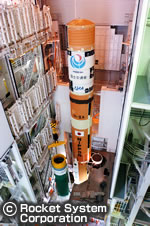 The launch of the Multi-functional Transport Satellite-1 Replacement (MTSAT-1R) aboard the H-IIA F7 is scheduled on the evening of Feb. 24. The launch is commissioned to Rocket System Cooperation and an official announcement of the launch date and time will be made after the launch plan is approved.
The launch of the Multi-functional Transport Satellite-1 Replacement (MTSAT-1R) aboard the H-IIA F7 is scheduled on the evening of Feb. 24. The launch is commissioned to Rocket System Cooperation and an official announcement of the launch date and time will be made after the launch plan is approved.
Launch operations are progressing well. The shape of the launch vehicle became apparent after the assembly of the first and second stages and solid rocket boosters (SRB-As) were completed.
January 20, 2005 Updated
Quick review of H-IIA booster test results and future schedule
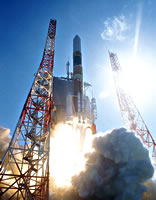 JAXA reported the quick review results of the solid rocket booster (SRB-A) static firing test held on Jan. 12 to the Space Activities Commission on Jan. 19.
JAXA reported the quick review results of the solid rocket booster (SRB-A) static firing test held on Jan. 12 to the Space Activities Commission on Jan. 19.
We are still analyzing the motor and nozzle to evaluate the design changes. The evaluation will be completed by the end of January. The launch date of the H-IIA Launch Vehicle No. 7 will be finally determined after the evaluation, but we currently plan to conduct a launch on the evening of Feb. 24 based on our preparation status.
January 13, 2005 Updated
Asian workshop on satellite utilization to prepare for disasters to be held in Kobe
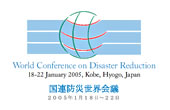 On January 20, the "Asian Work Shop on Satellite Technology Data Utilization for Disaster Monitoring" will be held at the Kobe Chamber of Commerce and Industry. The workshop is sponsored by JAXA as part of the United Nations World Conference on Disaster Reduction (between Jan 18 and 22 at Kobe). Reports and panel discussions are scheduled on the current status of the landslide analysis function of the Advanced Land Observing Satellite (ALOS), satellite data usage from the Nigata-Chuetsu Earthquake, and disaster prevention education and regional cooperation in Asia.
On January 20, the "Asian Work Shop on Satellite Technology Data Utilization for Disaster Monitoring" will be held at the Kobe Chamber of Commerce and Industry. The workshop is sponsored by JAXA as part of the United Nations World Conference on Disaster Reduction (between Jan 18 and 22 at Kobe). Reports and panel discussions are scheduled on the current status of the landslide analysis function of the Advanced Land Observing Satellite (ALOS), satellite data usage from the Nigata-Chuetsu Earthquake, and disaster prevention education and regional cooperation in Asia.
January 13, 2005 Updated
Solid Rocket Booster Static Firing Test Conducted
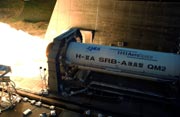 On Jan 12 (Wed), a static firing test on the qualification model of the improved solid rocket booster (SRB-A) was conducted at the Tanegashima Space Center. All scheduled test data was successfully acquired.
On Jan 12 (Wed), a static firing test on the qualification model of the improved solid rocket booster (SRB-A) was conducted at the Tanegashima Space Center. All scheduled test data was successfully acquired.
January 12, 2005 Updated
H-IIA Launch Vehicle No. 7 (H-IIA F7) arrived at the Tanegashima Space Center
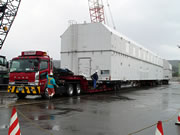 The core vehicle of the H-IIA F7 arrived at the Tanegashima Space Center on the 7th via Shimama Port in Tanegashima. Final launch operations, including mating operations with MTSAT-1R in the Vehicle Assembly Building (VAB), will soon commence.
The core vehicle of the H-IIA F7 arrived at the Tanegashima Space Center on the 7th via Shimama Port in Tanegashima. Final launch operations, including mating operations with MTSAT-1R in the Vehicle Assembly Building (VAB), will soon commence.
January 5, 2005 Updated
H-IIA Launch Vehicle No. 7 (H-IIA F7) left for Tanegashima
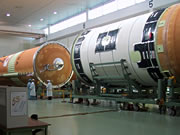 On Jan. 4, a transportation ship carrying the H-IIA F7 left the Tobishima Plant of the Nagoya Aerospace Systems Works of Mitsubishi Heavy Industries, Ltd. in Aichi Prefecture. After arriving at Shimama Port on Tanegashima Island, the H-IIA F7 will be transported by land to the Vehicle Assembly Building (VAB) at the Tanegashima Space Center for launch site operations including mating operations with its payload, the "MTSAT-1R."
On Jan. 4, a transportation ship carrying the H-IIA F7 left the Tobishima Plant of the Nagoya Aerospace Systems Works of Mitsubishi Heavy Industries, Ltd. in Aichi Prefecture. After arriving at Shimama Port on Tanegashima Island, the H-IIA F7 will be transported by land to the Vehicle Assembly Building (VAB) at the Tanegashima Space Center for launch site operations including mating operations with its payload, the "MTSAT-1R."